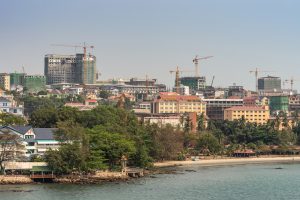More than a decade since the announcement of China’s Belt and Road Initiative (BRI), the ambitious project faces mounting scrutiny, despite its outward appearance of driving rapid development growth. The so-called BRI 2.0 vision, which promises to be “smaller, greener, and smarter,” is Beijing’s response to widespread criticism of the earlier phase of the BRI.
Cambodia, a key BRI recipient, offers a revealing case study of China’s evolving strategy. Between 2000 and 2021, China provided $17.7 billion to Cambodia through loans, grants, and donations of various kinds. Cambodia’s experience highlights both the transformative potential of Chinese investment and the challenges that risk undermining Beijing’s credibility and the long-term impact of its development model.
Some of these challenges stem from unintended side effects of China’s domestic policies. In the early 2000s, amid rapid economic growth, Beijing launched its “Going Out” strategy, encouraging companies to expand overseas. This policy aimed to enhance China’s global presence and address domestic overcapacity in sectors like steel and construction. With generous state incentives, concessional loans, and policy support, Chinese enterprises ventured abroad, laying the foundation for China’s global economic ambitions.
A decade later, the BRI built on this strategy, coordinating global infrastructure projects aligned with China’s geopolitical goals. While the “Going Out” strategy opened international markets to Chinese companies, the BRI provided a structured framework for these efforts. However, this expansion also enabled less scrupulous actors to exploit incentives, leading to poorly regulated investments in countries like Cambodia. Weak governance in these nations created a fertile environment for illegal activities such as money laundering, human trafficking, and online fraud. This, in turn, has tarnished the broader reputation of China’s global engagement, while also contributing to socioeconomic economic challenges in Cambodia.
The coastal city of Sihanoukville serves as a glaring example of these unintended consequences. Between 2016 and 2018, an estimated $1 billion in Chinese capital flooded the city, much of it fueled by unregulated investments during this “Going Out” boom. Real estate projects and casinos transformed the coastal hub into a magnet for Chinese investors and workers. But this rapid growth came at a cost. Infrastructure was overwhelmed, and the city became synonymous with organized crime, fraud, and exploitation.
Adding to this, the frenzy of construction during the boom left a lasting mess. Nearly 400 out of the 1,000 buildings erected with Chinese investment have been abandoned or remain unfinished, burdening local authorities with the task of managing these neglected properties. This oversupply reflects the lack of both long-term planning and regulation during the height of Chinese investment in Sihanoukville.
Compounding the issue is the misuse of the BRI brand. In Cambodia, some private Chinese firms unaffiliated with Beijing have falsely aligned themselves with the BRI to attract investment and legitimacy. These ventures, operating outside regulatory frameworks, have caused significant harm to local communities while undermining the credibility of the initiative itself. The lack of effective governance and oversight over such projects raises serious questions about the sustainability of China’s global ambitions.
Despite these challenges, the BRI has indeed delivered tangible benefits to Cambodia. Chinese investment has reshaped the country’s infrastructure landscape through highways, bridges, and Special Economic Zones. Most notably, the recently completed first-ever Phnom Penh-Sihanoukville Expressway has improved connectivity and reduced travel times between Cambodia’s largest coastal city and the capital. At the same time, Chinese-backed projects have contributed to Cambodia’s foreign direct investment growth, which averaged 12.1 percent of GDP annually between 2012 and 2022.
However, the structural limitations of this growth model are increasingly evident, raising questions about its long-term sustainability. A key issue is that much of Chinese aid in Cambodia comes with conditions requiring the use of state-owned or certified Chinese enterprises as contractors. This approach fosters dependency, reduces skill transfer to local industries, and perpetuates a model where infrastructure is built quickly but which does little to cultivate a resilient or inclusive economy.
The environmental and social consequences of some projects further complicate the narrative. The Lower Sesan 2 hydropower dam, completed in 2018, was built to boost Cambodia’s energy supply but displaced nearly 5,000 people, primarily Indigenous communities, while destroying critical ecosystems. Such projects highlight the risks of prioritizing speed and cost over sustainability and comprehensive planning. Without integrating social, economic, and environmental factors – or addressing the concerns of local communities – these initiatives risk creating long-term vulnerabilities that outweigh their short-term benefits.
After all, while Chinese financial resources have brought immediate benefits to Cambodia, the lack of accountability in some projects has exposed deeper vulnerabilities. The hype surrounding the BRI has often overshadowed the negative social and environmental impacts, particularly for vulnerable communities.
As Cambodia navigates the evolving BRI, it must move beyond being a passive recipient and actively shape its growth strategy. This shift requires recalibrating Cambodia’s relationship with China and committing to sustainable and responsible development. Without this, the BRI risks failing to reach its full potential, both in Cambodia and in the broader Global South.
The lessons from Cambodia’s BRI experience extend far beyond its borders. Development is not just about financing or infrastructure; it is about ensuring that investments are inclusive, sustainable, and accountable to local communities. For the BRI to succeed in its “2.0” iteration, it must address these principles and demonstrate that China’s model of development can evolve to meet the actual needs of recipient nations without harming vulnerable groups.
For Cambodia, this is an opportunity to recalibrate its relationship with foreign investments and set a new standard for responsible growth. By critically engaging with both China and other development partners, Cambodia can position itself as a model of resilience, sovereignty, and long-term sustainability.

































